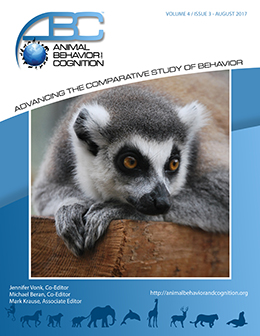Vol 4, Issue 3, August 2017
Recognition of Human Face Images by the Free Flying Wasp Vespula vulgaris
Citation
Avarguès-Weber, A., d’Amaro, D., Metzler, M., Garcia, J. E., & Dyer, A. G. (2017). Recognition of human face images by the free flying wasp Vespula vulgaris. Animal Behavior and Cognition, 4(3), 314-323. https://doi.org/10.26451/abc.04.03.09.2017
Abstract
The capacity to recognize perceptually similar complex visual stimuli such as human faces has classically been thought to require a large primate, and/or mammalian brain with neurobiological adaptations. However, recent work suggests that the relatively small brain of a paper wasp, Polistes fuscatus, possesses specialized face processing capabilities. In parallel, the honeybee, Apis mellifera, has been shown to be able to rely on configural learning for extensive visual learning, thus converging with primate visual processing. Therefore, the honeybee may be able to recognize human faces, and show sophisticated learning performance due to its foraging lifestyle involving visiting and memorizing many flowers. We investigated the visual capacities of the widespread invasive wasp Vespula vulgaris, which is unlikely to have any specialization for face processing. Freely flying individual wasps were trained in an appetitive-aversive differential conditioning procedure to discriminate between perceptually similar human face images from a standard face recognition test. The wasps could then recognize the target face from novel dissimilar or similar human faces, but showed a significant drop in performance when the stimuli were rotated by 180°, thus paralleling results acquired on a similar protocol with honeybees. This result confirms that a general visual system can likely solve complex recognition tasks, the first stage to evolve a visual expertise system to face recognition, even in the absence of neurobiological or behavioral specialization.
